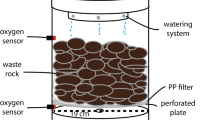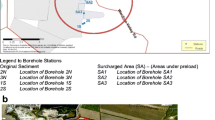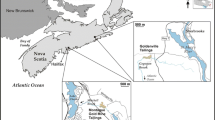Abstract
Saline-sodic shale overburden associated with oil sand mining is a potential source of salt release to surface water and groundwater and can lead to salinization and/or sodification of reclamation covers. Weathering of shale overburden due to oxidation of sulphide minerals within the shale leads to sulphate (SO4 2−) production and increased salinity. The controls on the rates of weathering of a shale overburden dump in the oil sands region of northern Alberta were determined from soil chemistry sampling and in situ monitoring of pore gases (O2, CO2, CH4) in three shallow profiles (1.9–4.45 m deep) and one deep (25 m deep) profile under reclamation covers of varying thickness. Oxidation, defined by the depth over which O2 concentrations were depleted, reached depths of approximately 1.1 m under the reclamation soil covers over a 6 year period after dump placement. Calculations of SO4 2− production rates and weathering depths were consistent with numerical simulations of the diffusion and subsequent consumption of atmospheric O2 in the overburden. The rate of SO4 2− production during the 6 year weathering period estimated from direct measurements of solids chemistry ranged from 0.70 to 8.3 g m−2 day−1. The rates calculated from the oxygen diffusion models were within that same range, between 1.6 and 4.1 g m−2 day−1.
抽象
油砂岩开采遗弃的盐沼相页岩顶板矸石为地表水和地下水潜在盐类释放源,会引起复垦盖层盐渍化。页岩内硫化物氧化风化将释放硫酸盐和增大盐度。通过分析加拿大北Alberta地区土壤样品化学成分、现场监测复垦层下浅层剖面(三个,深1.9-4.45m)和深层剖面(1个,深25m)孔隙气体(O2、CO2和CH4)变化,寻找控制复垦油页岩矸石风化速度的因素。依据复垦矸石堆内氧气浓度确定氧化反应深度。复垦处理六年之后,油页岩矸石氧化深度1.1m。计算的硫酸盐生成速度和风化深度与覆盖层中氧气扩散和消耗模拟结果一致。基于固体化学成分测量结果估算的硫酸盐生成速度为0.7-8.3 g•m-2•d-1。依据氧气扩散模型预测的硫酸盐生成速度与之一致,在1.6-4.1 g•m-2•d-1之间。
Zusammenfassung
Der salzhaltige Abraum aus dem Schiefer Abraum der Ölsandförderung ist eine potentielle Quelle der Versalzung von Oberflächen- und Grundwasser und kann zu einer Versalzungen der Rekultivierungsschicht führen. Verwitterung von Schiefer Abraumhalden aufgrund von Oxidation der Sulfidminerale innerhalb des Schiefergesteins führt zu Sulfat (SO4 2−) und erhöhtem Salzgehalt. Die Kontrolle der Verwitterungsraten der Schiefer Abraumhalden in den Ölsandregionen im nördlichen Alberta wurde mittels chemischer Bodenproben und InSitu Monitoring von Poren Gas (O2, CO2, CH4) ermittelt. Dies wurde an drei Oberflächenbohrungen (1,9 m-4,5 m Tiefe) und einer Tiefbohrung (25 m) in den Rekultivierungsschichten unterschiedlicher Dicke durchgeführt. Die Oxidation, gemessen an der Reduzierung des O2 Gehaltes im Verlauf der Teufe, erreichte eine Tiefe von ca. 1,1 m unter der Rekultivierungsschicht nach einer Zeitspanne von 6 Jahren nach Auftrag der Abraumschicht. Berechnungen zur SO4 2− Bildung und zur Verwitterungstiefe stimmten mit der numerischen Simulation der Diffusion und des O2 Verbrauches im Abraum überein. Der Grad der Bildung von SO4 2− während der sechsjährigen Verwitterungsperiode wurde durch direkte Messungen der Chemie des Festgesteins ermittelt und erreichte 0,70 bis 8,3 g/m2/d. Der Grad der Bildung von SO4, berechnet aus dem Sauerstoff Diffusionsmodell, erreichte ähnliche Beträge in Höhe von 1,6 bis 4,1 g/m2/d.
Resumen
Una escombrera de esquisto salino-sódico asociado con la minería de arenas petrolíferas es una fuente potencial de liberación de sal hacia aguas superficiales y subterráneas que puede alcalinizar y/o sodificar las coberturas de recuperación. La erosión del esquisto de la escombrera debido a la oxidación de minerales sulfurados dentro del esquisto lleva a la producción de sulfato (SO4 2−) y al incremento de la salinidad. Los controles sobre las velocidades de erosión de la escombrera ubicada en la región norte de Alberta fueron determinados a partir de muestreo del suelo y el monitoreo in situ de los gases (O2, CO2, CH4) en los poros de tres perfiles superficiales (1,9 − 4,45 m de profundidad) y en un perfil profundo (25 m de profundidad) debajo de la cobertura de recuperación de espesor variable. La oxidación, definida a partir de la profundidad a la cual las concentraciones de O2 eran insignificantes, alcanzó profundidades de 1,1 m bajo la cobertura de tierra de recuperación sobre un período de 6 años después de la ubicación del vertedero. Los cálculos de las velocidades de producción de SO4 2− y las produndidades de erosión fueron consistentes con las simulaciones numéricas de la difusión y el consumo subsecuente de O2 atmosférico en la escombrera. La velocidad de producción de SO4 2− durante el período de 6 años (estimado a partir de medidas directas de la química de los sólidos) estuvo comprendida entre 0,70 y 8,3 g m-2 d-1. Las velocidades calculadas a partir de los modelos de difusión de oxígeno estuvieron dentro del mismo rango, entre 1,6 y 4,1 g m-2 d-1.







Similar content being viewed by others
References
Aachib M, Mbonimpa M, Aubertin M (2004) Measurement and prediction of the oxygen diffusion coefficient in unsaturated media, with applications to soil covers. Water Air Soil Poll 156(1):163–193
Amos RT, Blowes DW, Bailey BL, Sego DC, Smith L, Ritchie AIM (2015) Waste-rock hydrogeology and geochemistry. Appl Geochem 57:140–156
ASTM (1996) Standard test method for particle size analysis of soils. D422-63; Annual Book of ASTM Standards, Vol 4.08, Philadelphia, pp 10–16
Birkham TK, Hendry MJ, Wassenaar LI, Mendoza CA (2007) A transient model of vadose zone reaction rates using oxygen isotopes and carbon dioxide. Vadose Zone J 6(1):67–76
Boese CD (2003) The Design and Installation of a Field Instrumentation Program for the Evaluation of Soil-Atmosphere Water Fluxes in a Vegetated Cover over Saline/sodic Shale Overburden. MSc Diss, University of Saskatchewan, Saskatoon
Chapman DE (2008) Hydrogeologic Characterization of a Newly Constructed Saline-Sodic Clay Overburden Hill. MSc Diss, University of Saskatchewan, Saskatoon
Elberling B (2005) Temperature and oxygen control on pyrite oxidation in frozen mine tailings. Cold Reg Sci Technol 41(2):121–133
Emrich, GH, GL Merritt (1969) Effects of mine drainage on groundwater. Groundwater 7(3):27–32
Gautier DL (1986) Cretaceous shales from the western interior of North America: sulphur/carbon ratios and sulphur-isotope composition. Geology 14(3):225
Gelinas P, Lefebvre R, Choquette M (1992) Monitoring of acid mine drainage in a waste rock dump. In: Singhal R, Mehrotra AK, Fytas K, Collins JL (eds), Environmental issues and waste management in energy and minerals production. Balkema, Rotterdam, pp 742–756
Government of Alberta (2016) http://www.alberta.energy.ca. Accessed 12 June 2016
Haug KM, Greene P, Mei S (2014) Geological Characterization of the Lower Clearwater Shale in the Athabasca Oil Sands Area, Townships 87–99, Ranges 1–13, West of the Fourth Meridian. AER/AGS Open File Report 2014-04. Alberta Energy Regulator/Alberta Geological Survey, Edmonton
Hendry MJ, Cherry JA, Wallick EI (1986) Origin and distribution of sulphate in a fractured till in southern Alberta, Canada. Water Resour Res 22(1):45–61
Hendry MJ, Mendoza CA, Kirkland RA, Lawrence JR (1999) Quantification of transient CO2 production in a sandy unsaturated zone. Water Resour Res 35(7):2189–2198
Hendry MJ, Barbour SL, Schmeling E, Mundle SO, Huang M (2016) Fate and transport of dissolved methane and ethane in Cretaceous shales of the Williston Basin, Canada. Water Resour Res 52:6440–6450
Hilderman, JN (2011) Net percolation as a function of topographic variation in a reclamation cover over a saline-sodic overburden dump. MSc Diss, University of Saskatchewan, Saskatoon
Huang M, Barbour SL, Carey SK (2015a) The impact of reclamation cover depth on the performance of reclaimed shale overburden at an oil sands mine in northern Alberta, Canada. Hydrol Process 29(12):2840–2854
Huang M, Hilderman JN, Barbour SL (2015b) Transport of stable isotopes of water and sulphate within reclaimed oil sands saline-sodic mine overburden. J Hydrol 529:1550–1561
Keller, CK, Bacon DH (1998) Soil respiration and georespiration distinguished by transport analyses of vadose CO2, 13CO2, and 14CO2. Global Biogeochem Cycles 12(2):361–372
Kelln CJ, Barbour SL, Qualizza CV (2007) Preferential flow in a reclamation cover: hydrological and geochemical response. J Geotech Geoenviron 133(10):1277–1289
Kelln CJ, Barbour SL, Qualizza CV (2008) Controls on the spatial distribution of soil moisture and solute transport in a sloping reclamation cover. Can Geotech J 45(3):351–366
Kelln CJ, Barbour SL, Qualizza CV (2009) Fracture-dominated subsurface flow and transport in a sloping reclamation cover. Vadose Zone J 8(1):96–107
Kessler S, Barbour SL, KCJ van Rees, Dobchuk BS (2010) Salinization of soil over saline-sodic overburden from the oil sands in Alberta. Can J Soil Sci 90(4):637–647
Lefebvre R, Hockley D, Smolensky J, Gelinas P (2001a) Multiphase transfer processes in waste rock piles producing acid mine drainage 1: conceptual model and system characterization. J Contam Hydrol 52(1–4):137–164
Lefebvre R, Hockley D, Smolensky J, Lamontagne A (2001b) Multiphase transfer processes in waste rock piles producing acid mine drainage: 2. applications of numerical simulation. J Contam Hydrol 52(1–4):165–186
Lottermoser BG (2010) Mine wastes: characterization, treatment and environmental impacts. Springer, Berlin
Mbonimpa M, Aubertin M, Aachib M, Bussière B (2003) Diffusion and consumption of oxygen in unsaturated cover materials. Can Geotech J 40(5):916–932
Meiers, GP, SL Barbour, CV Qualizza, BS Dobchuk (2011) Evolution of the hydraulic conductivity of reclamation covers over sodic/saline mining overburden. J Geotech Geoenviron 137(10):968–976
Mermut AR, Arshad MA (1987) Significance of sulphide oxidation in soil salinization in southeastern Saskatchewan, Canada. Soil Sci Soc Am J 51(1):247–251
Millard P, Midwood AJ, Hunt JE, Barbour MM, Whitehead D (2010) Quantifying the contribution of soil organic matter turnover to forest soil respiration, using natural abundance δ13C. Soil Biol Biochem 42(6):935–943
Miller JJ, Pawluk S, Beke GJ (1993) Soil salinization at a side-hill seep and closed basin in southern Alberta. Can J Soil Sci 73(2):209–222
Millington, RJ, Quirk, JP (1961) Permeability of porous solids. Faraday Soc Trans 57:1200–1206
Morin KA (1990) Problems and proposed solutions in predicting acid drainage with acid-base accounting. In: Gadsby J, Malick J, Day S (eds), Acid mine drainage: designing for closure. BiTech Publishers, Vancouver, pp 93–109
Nichol CF, Froese K, Sharma JS, Barbour SL (2016) Effects of oxidation on residual shear strength of shales within Lea Park Formation. Can Geotech J 53(12):1952–1964
Nordstrom DK (2011) Hydrogeochemical processes governing the origin, transport and fate of major and trace elements from mine wastes and mineralized rock to surface waters. Appl Geochem 26(11):1777–1791
Olatuyi SO, Leskiw LA (2014) Long-term changes in soil salinity as influenced by subsoil thickness in a reclaimed coal mine in east-central Alberta. Can J Soil Sci 94(5):605–620
Price WA, Errington J, Koyanagi V (1997) Guidelines for the prediction of acid rock drainage and metal leaching for mines in British Columbia: part I—general procedures and information requirements. In: Proceeding, 4th international conference on acid rock drainage (ICARD), Vancouver, BC, pp 1–14
Rhoades, JD (1982) Soluble salts. In: Page AL, Miller RH, Keeney DR (eds), Methods of Soil Analysis. Part 2, American Soc of Agronomy, Madison, WI, Agronomy Monograph no. 9, 2nd edit, pp 167–178
Sihota NJ, Mayer KU (2012) Characterizing vadose zone hydrocarbon biodegradation using carbon dioxide effluxes, isotopes, and reactive transport modeling. Vadose Zone J. doi:10.2136/vzj2011.0204
Sommerfeld, RA, Massman WJ, Musselman RC, Mosier AR (1996) Diffusional flux of CO2 through snow: spatial and temporal variability among alpine-subalpine sites. Global Biogeochem Cy 10(3):473–482
Spiers GA, Dudas MJ, Muehlenbachs K, Turchenek LW (1984) Mineralogy and oxygen isotope geochemistry of clays from surficial deposits in the Athabasca Tar Sands area. Can J Earth Sci 21(1):53–60
Sracek O, Choquette M, Gelinas P, Lefebvre R, Nicholson RV (2004) Geochemical characterization of acid mine drainage from a waste rock pile, Mine Doyon, Quebec, Canada. J Contam Hydrol 69(1–2):45–71
Steffen Robertson and Kristen Inc (1989) Draft Acid Rock Drainage Technical Guide—Vol 1. Prepared for the British Columbia AMD Task Force
van Stempvoort DR, Hendry MJ, Schoenau JJ, Krouse HR (1994) Sources and dynamics of sulphur in weathered till, western glaciated plains of North America. Chem Geol 111(1):35–56
Winston GC, Stephens BB, Sundquist ET, Hardy JP, Davis RE (1995) Seasonal variability in CO2 transport through snow in a boreal forest. In: Tonnessen KA, Williams MW, Tranter M (eds), Biogeochemistry of seasonally snow-covered catchments. International Associatuion Hydrological Sciences, Wallingford, pp 61–70
Yanful EK, Bell AV, Woyshner MR (1993) Design of a composite soil cover for an experimental waste rock pile near Newcastle, New Brunswick, Canada. Can Geotech J 30(4):578–587
Acknowledgements
The authors gratefully acknowledge the support of Syncrude Canada Ltd. as well as funding from the Cameco-Natural Sciences and Engineering Research Council of Canada Industrial Research Chair (MJH; Grant 184573) and a Syncrude-Natural Sciences and Engineering Research Council of Canada Industrial Chair (SLB; Grant 428588). We thank Stephanie Villeneuve for designing Fig. 1.
Author information
Authors and Affiliations
Corresponding author
Rights and permissions
About this article
Cite this article
Appels, W.M., Wall, S.N., Barbour, S.L. et al. Pyrite Weathering in Reclaimed Shale Overburden at an Oil Sands Mine near Fort McMurray, Canada. Mine Water Environ 36, 479–494 (2017). https://doi.org/10.1007/s10230-017-0454-4
Received:
Accepted:
Published:
Issue Date:
DOI: https://doi.org/10.1007/s10230-017-0454-4




